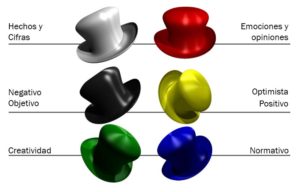I would like to share some concepts about what is called "Lateral Thinking" or also called creative thinking, this as always in schools and universities has stimulated logical thinking or vertical call, but despite being effective, it is incomplete. Why? Because logical thinking must be complemented by the creative qualities of lateral thinking.
Edward de Bono, professor at the University of Cambridge, in his book New Think: The Use of Lateral Thinking (1967), which refers to the technique that allows the resolution of problems with a creative approach. Lateral thinking is a specific way of organizing thought processes, which seeks a solution through unorthodox thought forms, which would normally be ignored by logical thinking.
The human brain leads us to use logical thinking in its interrelation with the environment. We use certain patterns that lead us to that logic, so what Bono promotes is looking for a disruptive element - which he defines as "provocation" - that makes us leave the box and take us to a different destination, forgetting about previous paradigms.
Differences between lateral thinking and logical thinking
Logical thinking is selective; lateral thinking is creative. Logical thinking selects the most promising approach to solving a problem; in lateral thinking, new approaches are sought and the possibilities of all of them are explored.
Logical thinking moves only if there is a direction in which to move; lateral thinking moves to create a direction. With the logician an experiment is designated to show some effect; with the lateral thought an experiment is designated to propitiate a change of the own ideas.

Elements of lateral thinking
We must highlight the four key elements in the "lateral thinking" process to face each challenge or creative challenge:
Checking assumptions: It is not always possible to approach a problem from a vertical thinking perspective and the solution may not be as straightforward as we thought. We must review these pre-established conventional assumptions, ideas or concepts whose validity is accepted without objection or examination. We need a "clear and open mind" to all the elements to face each situation.
Ask the right questions: The most important thing about lateral thinking is to know what questions we should ask ourselves. If we use this method to solve problems, we should start by asking simple and general questions to initially frame the problem. Next, we must examine the known data with much more specific questions by examining the most obvious hypotheses, until we reach an alternative vision close to the solution.
Creativity: Our imagination is a fundamental part of our creativity, becoming another key tool of lateral or creative thinking. In the end, it is about approaching each challenge creatively from another point of view. The lateral perspective will be more effective when solving apparently unconventional issues, where logic will not have space.

The best known techniques that stimulate creativity and therefore lateral thinking are:
- The provocations: When we evaluate a problem or situation we always tend to follow a natural or habitual pattern of thinking that limits us the ideas or conceptions (ex .: the chairs are for sitting, the floor for walking, the glasses serve to contain liquids, etc.). Through the provocations of thought we must get out of the path previously known.
- The six hats: Edward De Bono suggests in his book of "6 hats" is that something as simple as putting a hat on his head is in many cases a deliberate act. Thought should also follow this rule, "be deliberate and very careful". Thinking well, to live better, is a rule to follow and, therefore, nothing better than using "several hats" to achieve a varied, agile and creative style of thinking.
Thus, what this technique seeks is to represent six directions of thought contained in six imaginary hats. When a problem appears or we try to make a decision, each hat will offer us a premise, a vision, a specific framing. Once we have all used them proactively, we will feel more qualified to make a decision.
- White hat: we concentrate on the available data.
- Red hat: here we will use intuition, feelings and emotions
- Black hat: we will now focus on evaluation, wisdom and prudence. We will also think about the adverse and negative effects.
- Yellow hat: now we will evaluate the positive aspects optimistically
- Green hat: Here we will highlight creative elements.
- Blue hat: We think from the perspective of the process, control and management. The above is recapitulated and conclusions are reached.

- Analogies: It is about comparing in parallel some facts, some knowledge or different disciplines. Analogies are an instrument to confer new approaches to a problem, instead of merely relying on spontaneous inspiration. That is, instead of attacking it head on, it is compared to another problem or situation.
- Investment method: It consists of taking a principal considered as true and investing the elements that operate on that principle, with which a forced reordering of the information is provoked. (ex: cigars are smoked to people, the rope takes the hand, bicycles pedal people). It is about seeing the problem from different angles to approach another solution, more or less eccentric.
The lateral thinking in the company
This technique proposes an alternative problem solution that, in many cases, is a way of separating oneself from the competition and, even, of giving rise to a line of business in itself.
Perhaps one of the clearest examples of lateral thinking is the one that led 3M to use the adhesive that was not powerful enough for almost no use to sustain Post It notes. If they had applied logical thinking, they would have tried to improve the formula and would have another adhesive, but would not have brought to the market a solution that demanded almost without knowing it.
The objective of lateral thinking is not to elaborate correct ideas, but to elaborate a large number of creative ideas; be open to everything, and after the filter stay with the best.
"You do not have to be smart, but I think you have to be open to possibilities and be willing to explore. The only stupid people are those who are arrogant and closed "Edward de Bono
DO YOU WANT TO COMMENT ON THE RESPECT?
